We occasionally link to goods offered by vendors to help the reader find relevant products. Some of these may be affiliate based, meaning we earn small commissions (at no additional cost to you) if items are purchased. Here is more about what we do.
You can’t talk about fun homemade fermentation projects without giving kombucha at least an honorable mention!

More than just a silly fad or passing trend, kombucha and its characteristically sweet-and-sour taste is here to stay.
This fizzy, fermented beverage already holds prime real estate at many grocery stores – you might stroll past a large refrigerated wall dedicated to showcasing different brands, with a brilliant rainbow of colors and flavors shining bright underneath the fluorescent lights.
While you can pay for the convenience of plopping a few bottles in your cart, I challenge you to brew this refreshing carbonated drink completely from scratch.
Creating homemade kombucha is a realistic project to undertake when you’re craving a new at-home culinary experiment that caters to your individual taste preferences and creativity.
And unlike babysitting and meticulously tending to a sourdough starter, preparing homemade kombucha is a far more forgiving, playful, and laidback process.
But you do still need to understand and follow the proper fermenting techniques for safe and successful final results.
So, let’s chat about kombucha! What is it exactly, and how do you make it?
I’ll provide a brief explanation to begin, but you’ll find a more in-depth discussion in the detailed Cooking by the Numbers section below – so keep reading!
Here’s a quick preview of everything to come, up ahead:
How to Make Kombucha at Home
What Is Kombucha?
Kombucha is a fermented sweet tea drink made with a simple combination of plain water, tea leaves, granulated sugar, and assorted flavorings.
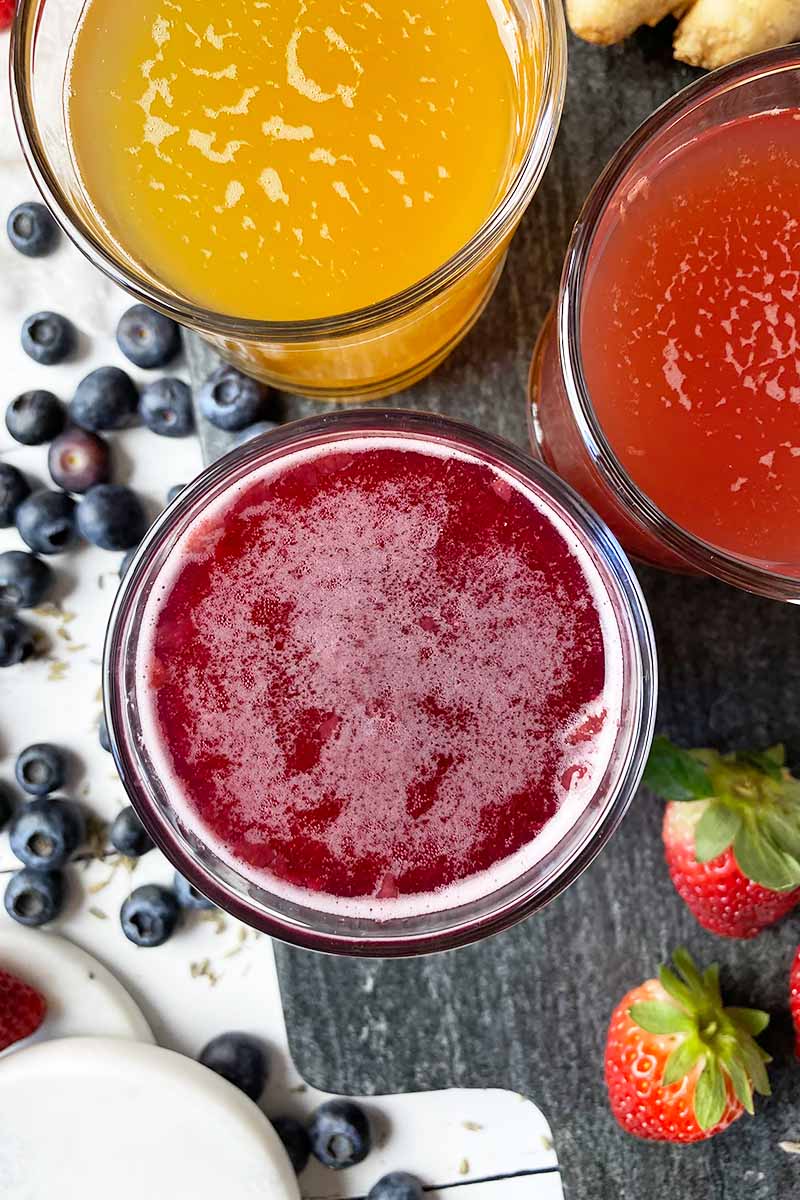
The carbonation level is controlled by two separate stages of fermentation at room temperature.
The natural yeasts, bacteria, and sugar combined in the liquid form a safe environment for natural fermentation to occur, creating a carbonated beverage with potential probiotic benefits.
How Do You Make It?
The first step of making kombucha is to brew a large batch of tea. Once brewed, you then sweeten it with sugar and allow this liquid to ferment at room temperature.
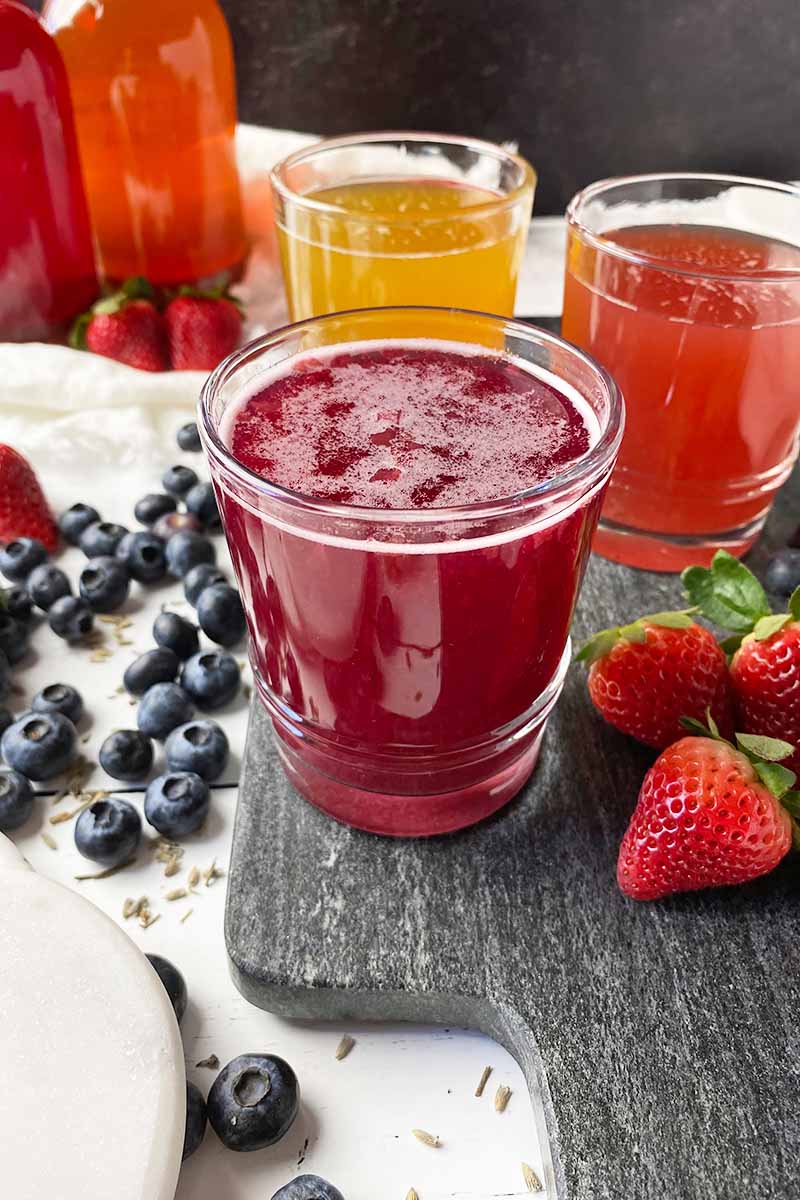
For the strongest and most successful fermentation, unflavored organic black tea is often used, but there can be variations depending on the recipe you choose to use.
Similar to making sourdough bread, in which every batch of dough relies upon a mother or starter from a previous batch, making kombucha requires a few additional ingredients to catalyze fermentation.
First Fermentation
In order to jumpstart the first fermentation, which may last anywhere from one to three weeks, the freshly brewed tea depends on the addition of two important ingredients: a starter tea and a SCOBY.
Starter Tea
The starter tea is often a previously made plain kombucha base that has gone through the first fermentation successfully. It has no added flavors, and has not gone through a second fermentation.
However, you can also use a plain, unflavored store-bought kombucha in a pinch, especially if this is your first time brewing and you don’t have any starter tea on hand.
SCOBY
SCOBY is an acronym that stands for “Symbiotic Culture Of Bacteria And Yeast.” It may also be referred to as a kombucha culture.
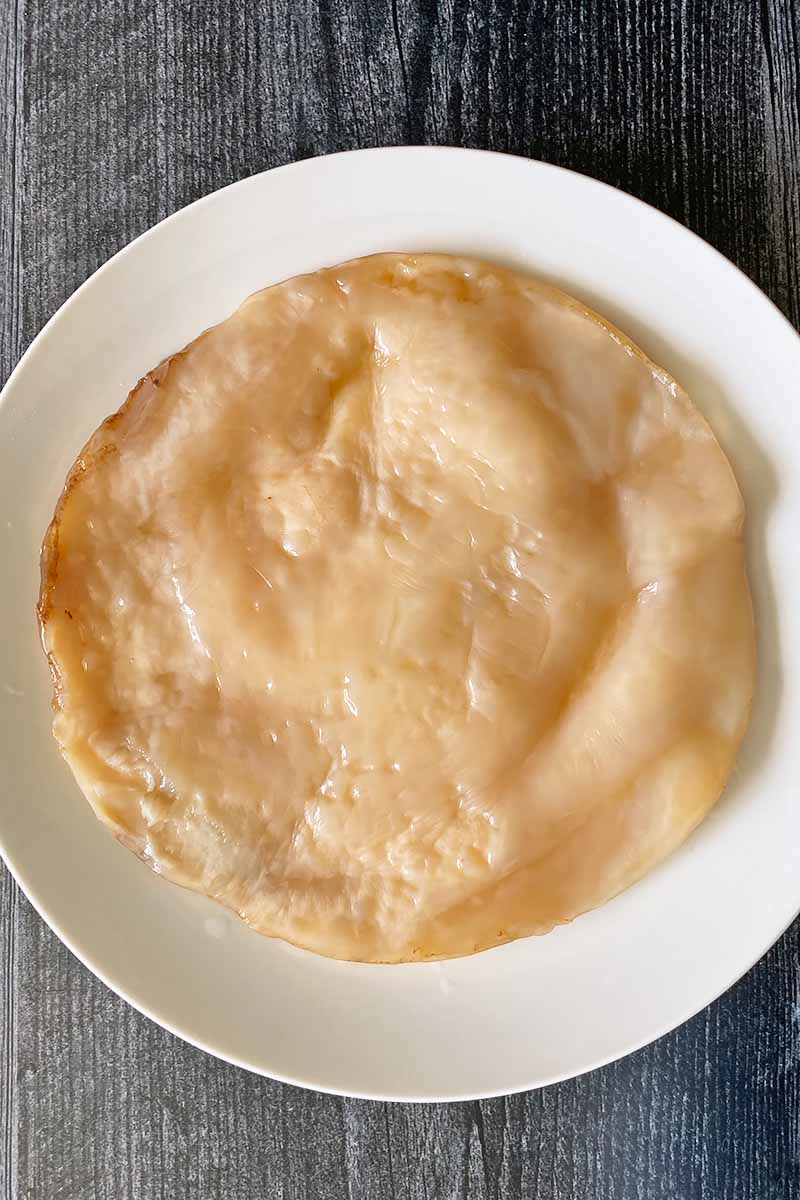
You add one to start, and these solid, gelatinous discs naturally form and float on the surface of the liquid each time you make a new batch of kombucha. They contain healthy cultures of bacteria and yeast.
They will take the shape of the container in which you brew the kombucha.
A healthy SCOBY will usually start out light cream or tan in color, and it will darken over time.
A darker color and thin, limp texture are clear indicators that your SCOBY is past its prime. If you notice these signs, or after you have used the same SCOBY for 2 to 3 different rounds of making kombucha, you can dispose of it.
Don’t worry – you’ll have plenty of fresh SCOBY after making each new kombucha recipe!
Second Fermentation
The second fermentation occurs after you have flavored, bottled, and sealed your kombucha in smaller containers to hold individual servings.
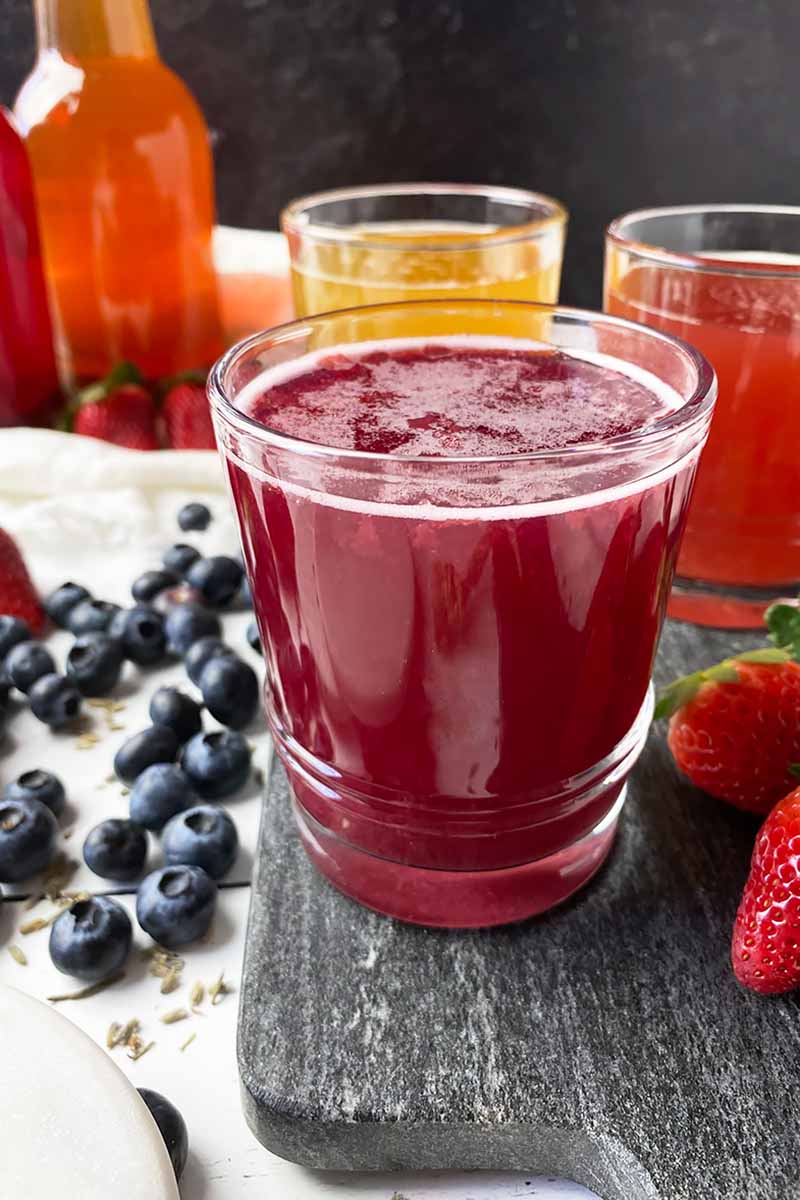
The flavors you use are completely up to your personal taste preferences. Ideally, you would use a liquid option for the flavoring component, such as a fruit or sugar syrup, juice, or puree.
With this additional sugar, the microbes in the kombucha continue to convert the sugar into a trace amount of alcohol at this stage, and develop more carbonation.
This sealed fermentation step only lasts for a few days at room temperature, before refrigerating and serving.
Once the bottled kombucha has chilled long enough to halt fermentation, it’s ready to drink and enjoy!
The Recipe
Now that you understand these kombucha basics and the lingo surrounding the process of making it, are you ready to make your own batch?
The recipe is all yours! Go forth, and ferment!
Print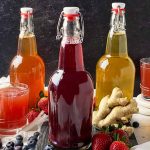
Homemade Kombucha
- Yield: 6 16-ounce bottles 1x
Description
Want to make your own kombucha? With Foodal’s recipe and thorough step-by-step guidelines, learn what you need to know about this fizzy drink.
Ingredients
For the First Ferment:
- 12 cups room temperature water, divided (96 fl oz)
- 8 individually-sized organic black tea bags (or about 3 tablespoons loose organic black tea)
- 1 cup organic granulated sugar (201 g)
- 2 cups reserved starter tea or plain kombucha (16 fl oz)
- 1 SCOBY
For the Second Ferment:
- 3/4–1 1/2 cups fruit puree, juice, syrup, or plain or flavored simple syrup, divided
Instructions
For the Base:
- Place 6 cups of water in a large 4-quart pot. Transfer to the stovetop and bring to a boil. Remove the pot immediately from the heat.
- Add the sugar, whisking until dissolved.
- Submerge the tea bags in the hot water. Steep for 25 minutes.
- Remove and dispose of the tea bags. Pour in the remaining 6 cups of water and whisk to combine.
- Let cool to room temperature, no higher than 75°F, whisking occasionally.
- Whisk in the starter liquid.
For the First Ferment:
- Carefully pour the base liquid into a clean 1-gallon glass jar. Gently add the SCOBY to the liquid.
- Wipe away any excess liquid droplets around the rim and outside of the glass jar with a clean towel or paper towel.
- Cover the top of the jar with a clean, lint-free, tight-weave cloth such as a kitchen towel, bandana, or t-shirt. Tightly secure the cloth around the rim with one or two rubber bands.
- Carefully transfer the jar to a flat and stable surface in a location of the house that is between 65 and 75°F with good airflow, away from any direct sunlight. Do not place it in a tight, dusty, enclosed location without adequate airflow like a cabinet.
- Allow the jar to sit undisturbed for 1 week before testing. A new SCOBY will start developing on top of the liquid.
- Remove the towel from the top and insert a clean straw or ladle to remove and taste some of the liquid. The liquid should have an approachable, but not overpowering, sour or vinegar-y taste to it, and it should be subtly sweet.
- If you prefer a more sour taste, resecure the opening of the jar with the towel and rubber bands and allow it to sit for 5 more days before retesting.
- Continue retesting in 5-day increments to achieve your preferred level of acidity. This could take 1-3 weeks total.
For the Second Ferment:
- When the liquid has reached your preferred level of sourness, remove the towel. Remove the SCOBY that formed on top of the liquid, and store it to make another batch of kombucha.
- Set out 6 16-ounce Grolsch bottles assembled with airtight swing-top caps.
- Using a funnel, pour 1/8 to 1/4 cup of fruit puree, fruit juice, fruit syrup, or simple syrup in each of the bottles.
- Using a funnel, pour the kombucha into each bottle, leaving about 3/4-inch headspace at the top.
- Wipe off any excess liquid at the lip of the bottles with a clean towel and seal each bottle with the swing cap. Do not shake.
- Store the bottles in the same location where you completed the first fermentation, or preferably in a closed cabinet in case of potential carbonation explosions. Good airflow is not necessary for this step.
- Allow the liquid to ferment undisturbed for 1-3 days.
- Transfer to the refrigerator to halt fermentation. Chill for at least 24 hours before opening and drinking.
- Sealed bottles may be stored in the refrigerator for up to 30 days. Store open bottles in the refrigerator for up to 3 days.
- Category: Tea
- Method: Fermentation
- Cuisine: Beverage
Keywords: kombucha
Cooking by the Numbers…
Step 1 – Prep
First, prepare yourself for an adventure that may last for weeks – though most of this time will be passive, are you ready for that commitment?
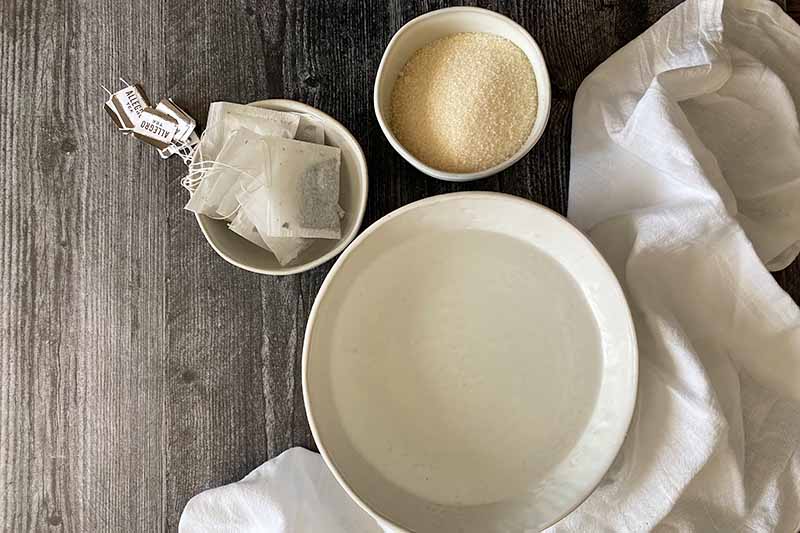
Yes? Good!
Now, let’s break down the tools and ingredients that you will need for the first and second fermentation.
First Fermentation Ingredients and Tools:
There are some very important ingredients and tools that you will need to start the recipe. Make sure you have them all ready before you begin.
Tools and Utensils:
- Liquid and dry measuring cups
- Whisk or mixing spoon
- Kitchen or paper towels
- Lint-free, tight-weave cloth
- Rubber bands
- 1 4-quart pot
- 1 1-gallon glass jar
- Straw or small ladle
- Disposable gloves
- Thermometer
Ingredients:
- 12 cups water
- 1 cup organic granulated sugar
- 8 bags unflavored organic black tea or 3 tablespoons loose-leaf organic black tea
- 2 cups starter tea
- 1 SCOBY
For the fermentation process, it’s best to store the kombucha in a glass jar, rather than a reactive metal material or porous plastic. The nonporous and nonreactive glass will not absorb any smells or stains from the liquid, and it will be easy to clean.
You should also choose a jar that has a wide, open mouth – this will be best for allowing proper airflow, and it will be easier to pour the liquid into and out of the opening.
This set of two 1-gallon glass jars from Amazon will be perfect!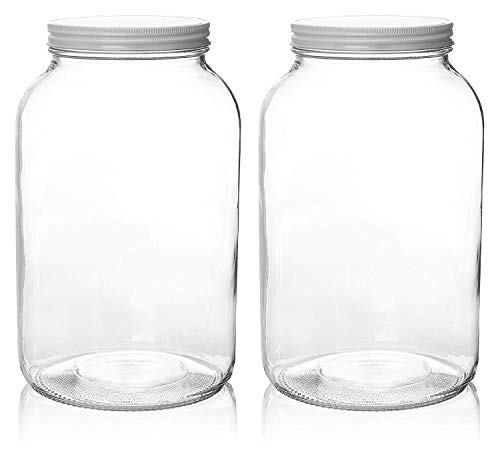
Kitchentoolz 1-gallon glass jars, set of two, available from Amazon
For your sugar and tea, organic is best, so there are no byproducts potentially interrupting the natural fermentation.
For the same reason, avoid any flavored tea varieties. In order to yield the strongest and most successful kombucha product, it’s best to use black tea for your first few rounds of kombucha-making. Flavors can be added during the second ferment.
Once you have developed a good technique and routine, you can start to experiment with different ratios of multiple varieties of black, green, or white tea – use any variety, as long as it does not include any added ingredients or flavorings other than the tea itself.
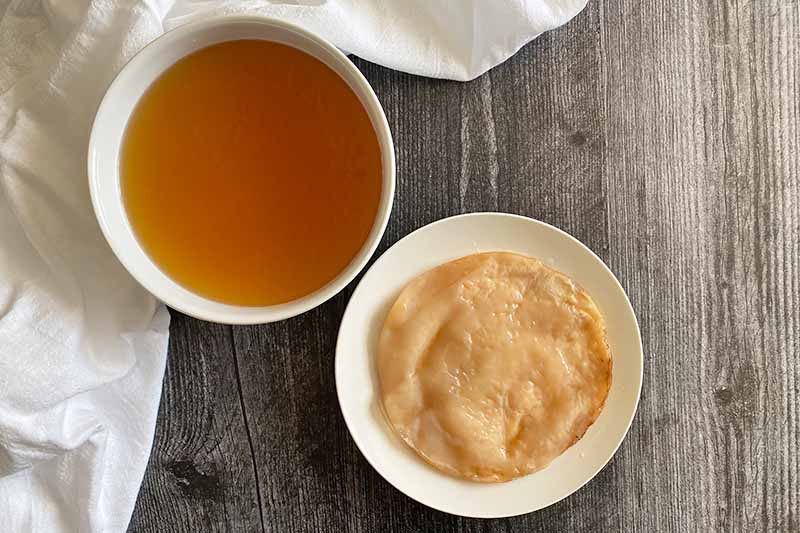
Your starter tea can be 2 cups of first-ferment liquid saved from a previous batch. You can also use plain unflavored store-bought kombucha.
For the SCOBY, you can use a healthy one saved from a previous batch. If this is your first time making kombucha, there are products available to purchase online.
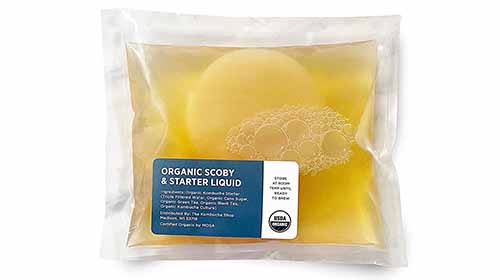
Urban Kitchen organic SCOBY, pack of 1, available on Amazon
Consider buying this organic SCOBY from Urban Kitchen, available on Amazon.
You can also buy plain starter tea, like The Kombucha Company’s 16-ounce starter tea that’s also available on Amazon.
Second Fermentation:
Because you may have to order bottles and make purees and syrups, it’s smart to know ahead of time what equipment and ingredients you’ll need for the second round of fermentation as well.
Tools and Utensils:
- Paper or kitchen towels
- Ladle
- Small funnel
- Pitcher or pitcher-style measuring cup
- 6 16-ounce glass Grolsch bottles
Ingredients:
- 3/4 cup to 1 1/2 cups fruit puree, juice, fruit syrup, or simple syrup
Similar to the first fermentation, it will be best to store the kombucha in glass bottles for the second fermentation and final storage. However, the bottles must have an airtight top to maintain the carbonation.
I think 16-ounce glass Grolsch bottles are the ideal vessels, and you can buy a set of 6 on Amazon now.
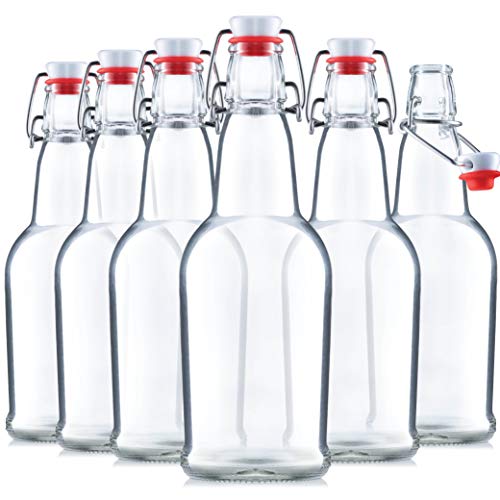
Paksh Novelty 16-ounce flip-top glass bottles, set of 6, available on Amazon
While you can buy these in a tinted glass color, I prefer the clear glass bottles so you can see your beautiful kombucha! And because you will be storing them in a dark refrigerator, you will not have to worry about excessive light exposure.
We’ll discuss the flavoring ingredients in more detail in a later step!
Step 2 – Make the Sweetened Tea
Before beginning, make sure your hands and work location are clean! Contaminants on your hands or work surface may potentially cause the kombucha to fail. You can choose to wear gloves for the entirety of the prep steps.
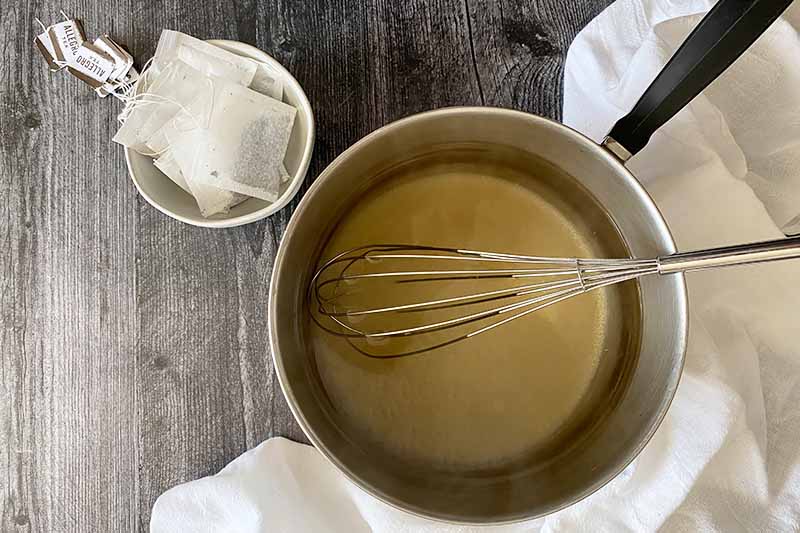
Pour 6 cups of water into a large pot. Transfer this to the stovetop and bring it to a boil over high heat.
Immediately remove the pot from the heat and transfer it to a heatproof surface. Whisk in the sugar until it dissolves completely into the hot water.
Submerge each of the 8 tea bags in the sweetened water. If you’re using loose-leaf tea, place the leaves in a tea infuser, like this 3-inch silver mesh tea infuser available on Wayfair.
Silver mesh tea infuser, 3 inches, available on Wayfair
If you do not have a tea infuser, strain the steeped liquid through a fine-mesh strainer before adding the remaining water.
Steep the tea for 25 minutes – the liquid will darken and it will be very aromatic. You are creating a tea concentrate in this step before adding the remaining liquid. And there’s no need to keep it warm so don’t place a lid on top of the pot.
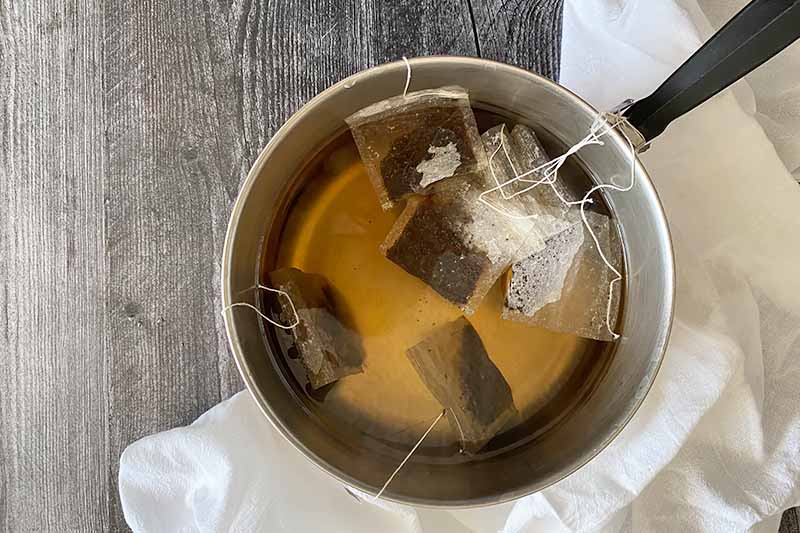
After infusing, remove and dispose of the tea bags. Whisk in the remaining 6 cups of water.
At this point, you want to cool the water down to room temperature. Adding the starter tea and SCOBY to hot liquid may negatively impact the fermentation process, killing the live bacteria and yeasts.
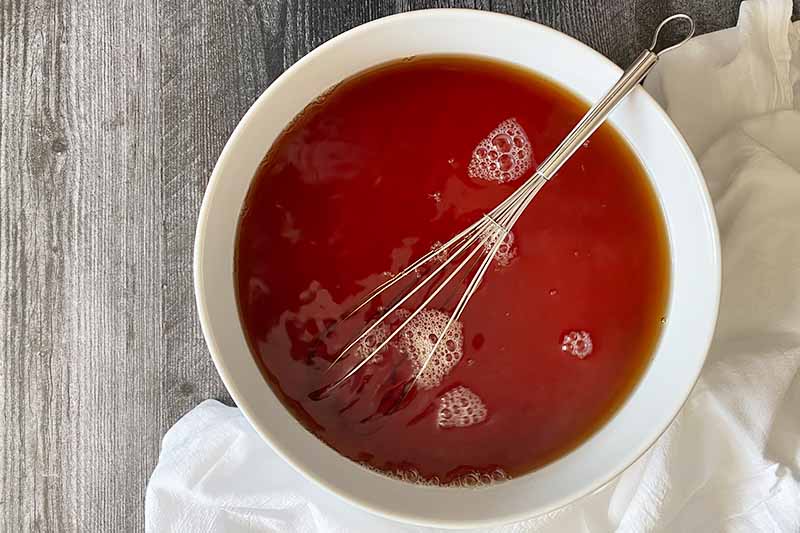
Cool the liquid to room temperature, until it’s no warmer than 75°F. Whisk the base occasionally to promote even cooling.
Once cooled to the right temperature, add the two cups of starter tea and whisk to combine.
Step 3 – Transfer Base to Jar
Make sure your 1-gallon glass jar is clean and free of any debris. Remove the lid from the jar and store it elsewhere.
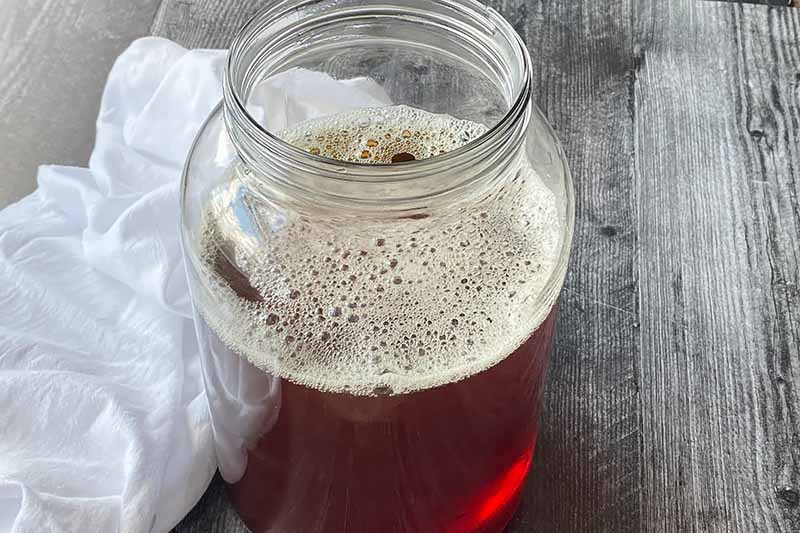
Pour the room temperature base liquid into the glass jar. Use a ladle or liquid measuring cup with a spout to help cleanly transfer the liquid from the pot to the jar.
With clean hands, or while wearing gloves, gently place the SCOBY into the liquid. The SCOBY may float or sink – this does not determine its quality.
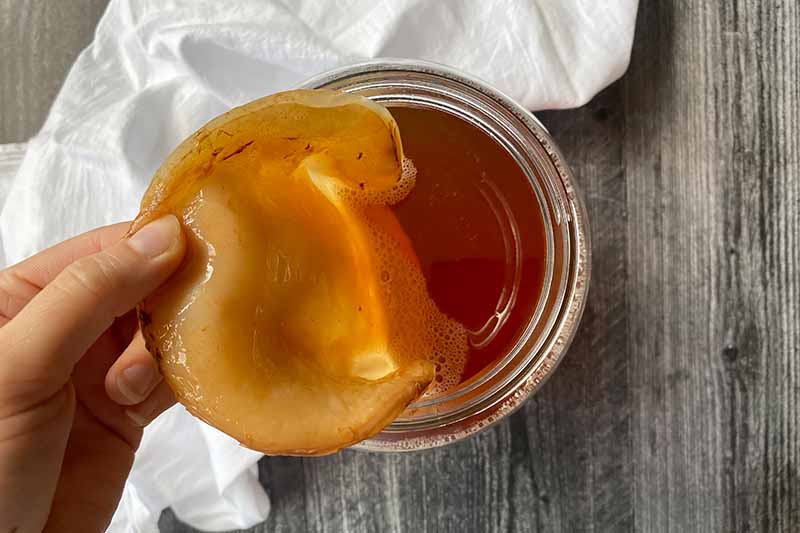
With a paper or kitchen towel, wipe away any excess liquid droplets around the rim and outside of the glass jar.
Cover the top opening of the jar with a clean, lint-free, tight-weave cloth. You can use various types of cloth such as a tea towel, bandana, or t-shirt.
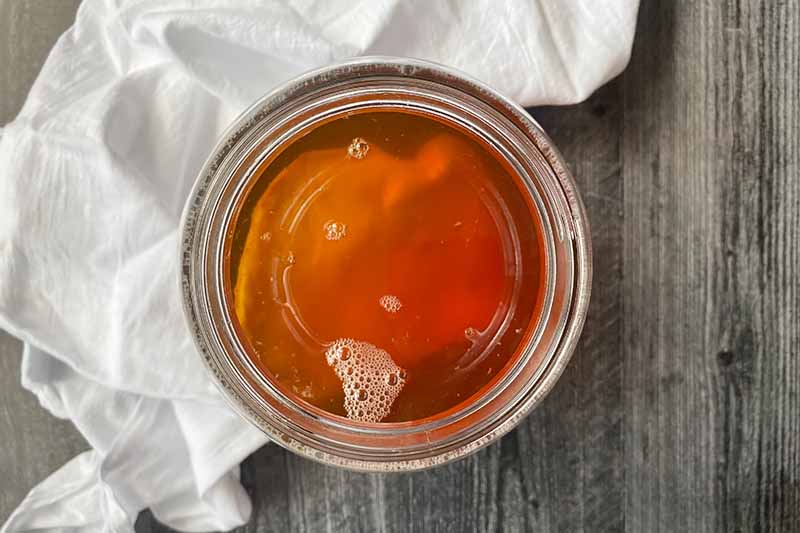
Do not use cheesecloth for the covering! The loose construction of the thread is not a safe storage option, as the openings will be large enough for flies, other insects, or other contaminants to enter.
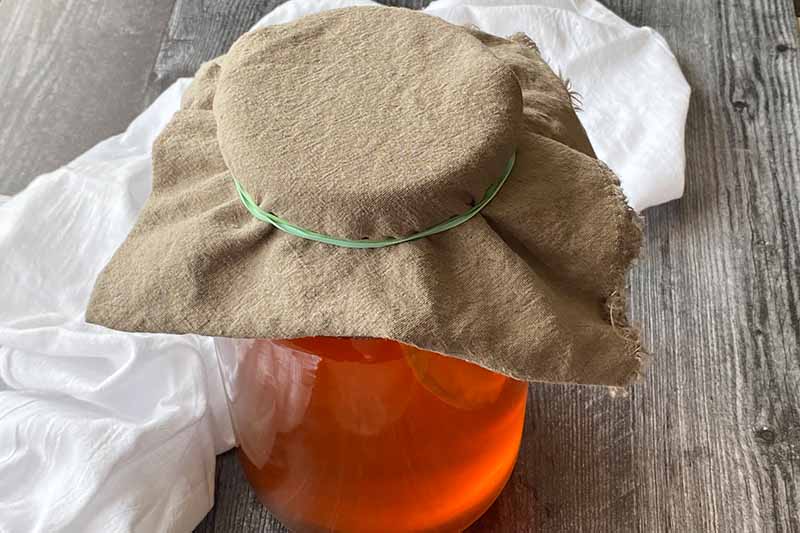
Tightly secure the cloth around the top of the jar with one or two rubber bands. The cloth should be taut and it should cover the opening of the jar completely.
Step 4 – First Ferment
Without shaking or moving the jar excessively, carefully transfer it to a location of the house that stays between 65 and 75°F.
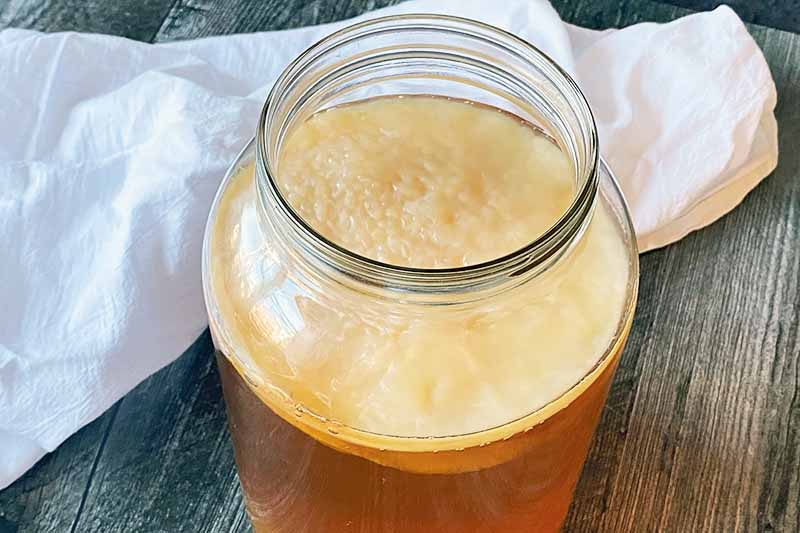
You want the liquid to be stored away from direct sunlight. Not only will the warmth from direct sunlight cause the temperature of the room in which you are storing your kombucha to fluctuate, sunlight can also impair fermentation, as the ultraviolet rays have antimicrobial properties.
You also want the liquid to not be stifled during this first fermentation – allow enough airflow by keeping the jar in an open location, not a tight, dusty, or enclosed cabinet or closet.
The jar should also be placed on a stable and flat surface.
Allow the jar to sit undisturbed for 1 week before testing. Take note of the timeframe so you know when to check – you can label the jar, or you can write a note in a calendar.
The contents in the jar may start to emit a subtle vinegary smell, and the original SCOBY may float or sink.
During this time, you should start to see a new SCOBY developing on top of the liquid – this is a visual sign that your liquid is healthy and properly fermenting – yay!
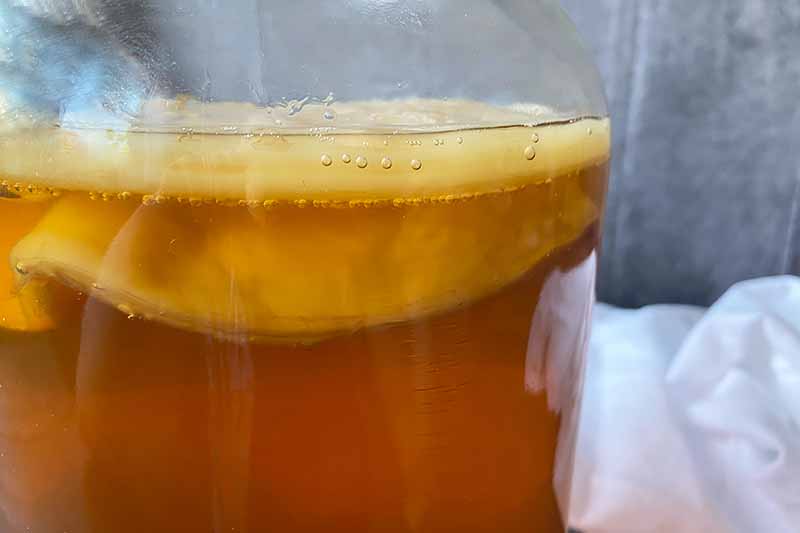
The SCOBY will start out as a thin, slightly see-through, gelatinous film on top, and will continue to grow, thicken, and darken in color.
You may notice some excess growth on the SCOBY, like brown strand-like pieces attached to it. This is not a concern, and is another sign of healthy growth.
However…
If the SCOBY looks like there is fuzzy mold growth on it in a blue, white, green, or black color – like the nasty kind you might find on old bread or cheese – this is a telltale sign that your base has become contaminated and is no longer safe to consume.
You will need to dispose of everything – everything! – in the jar and restart the entire process with a new SCOBY.
Don’t be discouraged! Mistakes happen in the kitchen! The second time around, make sure all of your products and equipment are clean, and that you are following the recipe and proper storage protocols closely.
Step 5 – Taste Test
After the first week of fermenting, the base is ready for the first taste test to check its status. Carefully transfer the jar to a clean work surface for testing.
Remove the rubber bands and towel from the opening, and insert a clean straw or ladle into the liquid. Pull out some of the liquid, and taste it.
How does it taste? Take note of its flavor and texture.
At this point the liquid should have a subtly acidic taste, like vinegar. It should not be overpoweringly sour. You’re looking for an approachable sour taste here, but it should still be slightly sweet.
As for the texture, there may or may not be some effervescence – that will continue to develop during the second fermentation.
If you’re happy with the taste, you’re free to move on to the second fermentation!
However, if you prefer a stronger sour taste, the base needs more time to ferment. Re-secure the opening of the jar with the towel and rubber bands and allow it to sit for 5 additional days.
Continue retesting in 5-day increments to achieve your preferred level of acidity. Depending on how strong you want the kombucha to taste, this can range anywhere from a total of 1 week to 3 weeks.
Step 6 – Prepare the Flavorings
As you are nearing the end of the first fermentation, now is the time to prepare your flavorings.
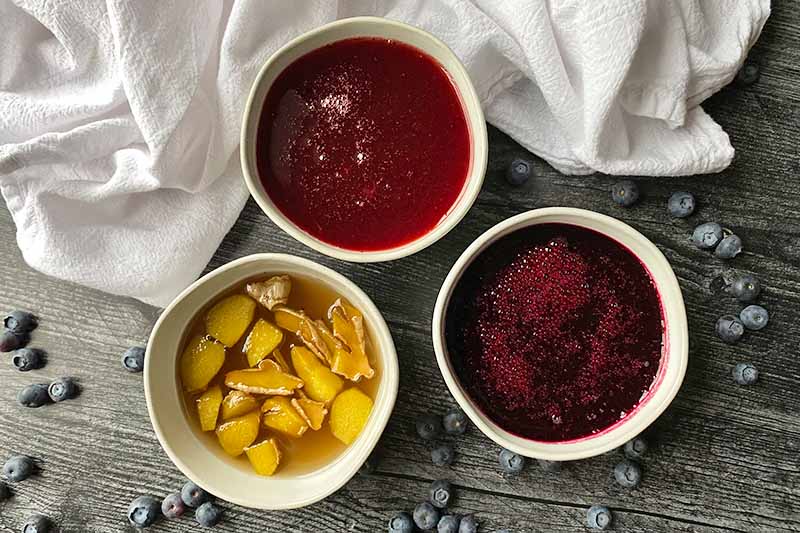
Flavorings for kombucha will vary from recipe to recipe – you will see recipes using whole pieces of fruit, fruit juice, fruit syrup, fruit puree, or an unflavored or flavored simple syrup.
I highly encourage you to research and try different methods!
All of these are acceptable to use, but they will yield different results. As you continue to experiment with each new kombucha batch, your own personal experiences and preferences will eventually guide you to what you like the most.
In my own experience, I prefer to use natural fruit-flavored syrup recipes. A concentrated, liquid syrup will more easily blend with the base, and you’re able to control the sugar content better than you might with a plain piece of fresh fruit, whose sweetness level can vary depending on the season or level of ripeness when it was harvested.
Also, the bottles are far easier to clean when you’re done if you’re using an all-liquid mixture, rather than having to fish out chunks of mushy, unappetizing fruit pieces!
I have used homemade fruit syrups with great success throughout the past few years of making my homemade kombucha.
Try any of our berry syrup recipes, and play around with any additional flavorings as you are cooking the fruit and sugar together. For example, add a few slices of fresh ginger, dried lavender, or other spices.
Just be sure to strain out any ingredients you might be using for infusing before you start filling the bottles in the next step.
When using juice, puree, or syrup, stay within the range of 1/8 to 1/4 cup per 16-ounce bottle.
I would advise against adding any more than 1/4 cup – you don’t want to add an excessive amount of additional sugar, or else the liquid may over-ferment and over-carbonate in the bottle, causing a forceful explosion of the contents inside when you release the cap for the first time.
Step 7 – Assemble in Grolsch Bottles
When you’re ready to assemble, set out 6 16-ounce Grolsch bottles with airtight swing-top caps on a clean work surface. Set out the flavorings you have chosen to use.
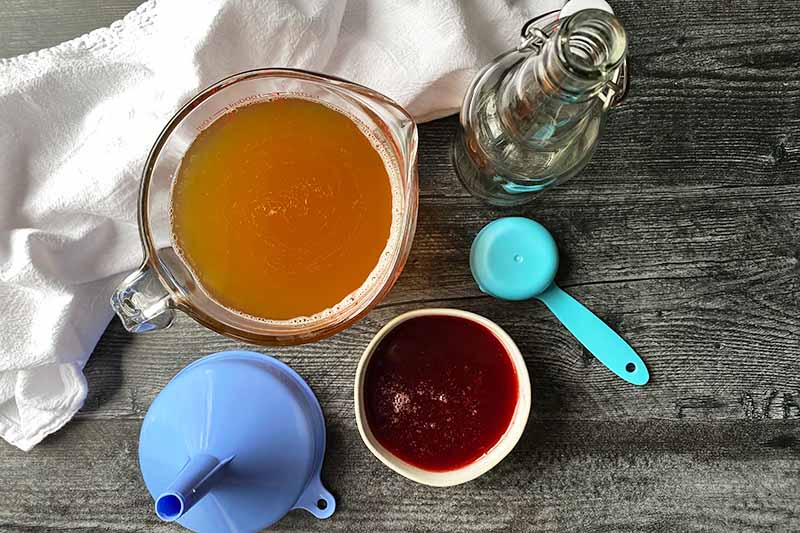
Set out the jar with the kombucha base, and remove the rubber bands and towel. With clean hands, wearing gloves if you choose, remove the SCOBY and set it aside for storage – more on that soon.
Whisk the liquid thoroughly.
Using a funnel, pour 1/8 to 1/4 cup of fruit puree, fruit juice, fruit syrup, or simple syrup into each bottle. The amount that you should add will depend on how sweet you want the kombucha to be.
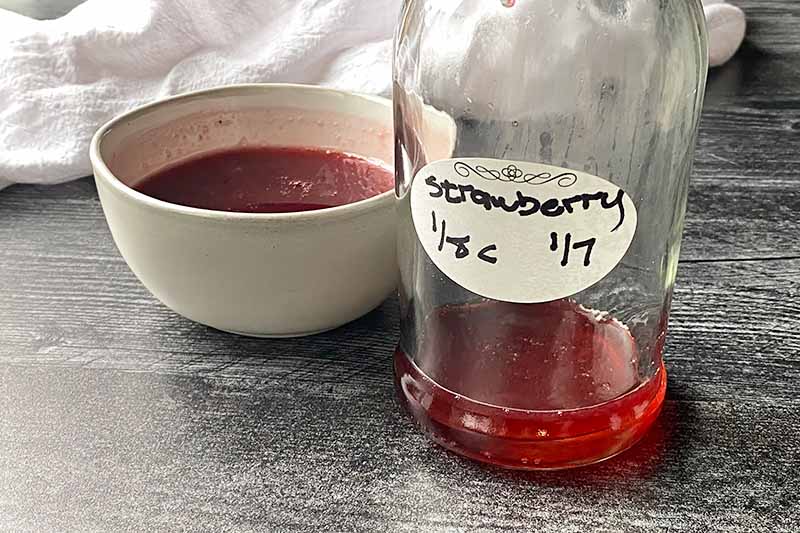
Next, pour the kombucha into each bottle, using a funnel and ladle. There will still be about 2 cups remaining to set aside for storage – more on that soon, as well!
Leave about 3/4 inch of headspace at the top of each bottle – you want to leave some space for the carbonation to develop.
Wipe off any excess liquid from the lip of each bottle with a clean towel. Seal each bottle with the swing cap.
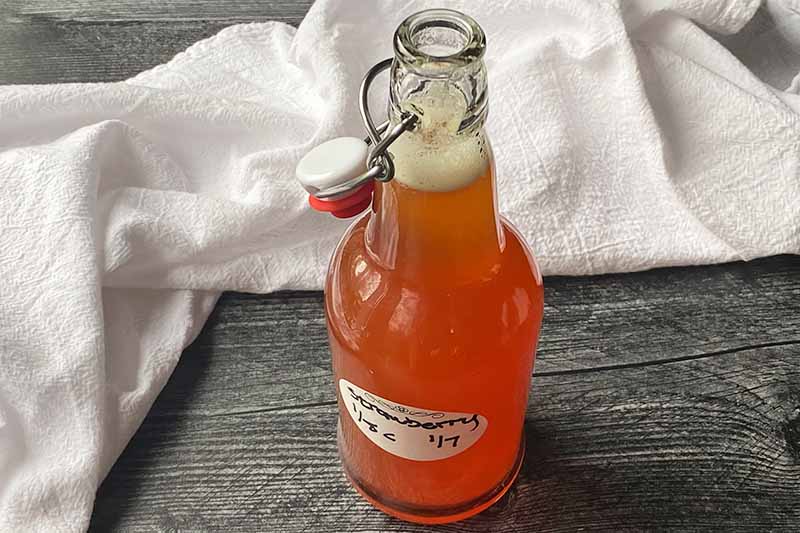
Please do not shake!
After filling the bottles, you will have some starter tea from your first ferment left over.
Step 8 – Store the SCOBY and Starter Tea
You now have doubled your SCOBY stash for future use – you still have the first SCOBY you used for the base, and now you have a completely new one that formed on top.
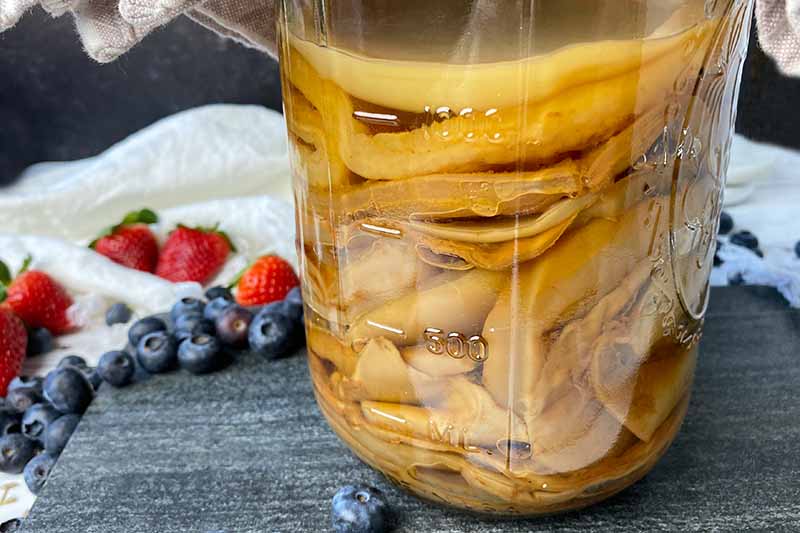
Save them both!
SCOBY has a significant shelf-life – even after multiple use, it can last for months when stored properly. And it doesn’t need much TLC!
Start a “SCOBY Hotel,” what the storage area for the SCOBY is popularly called.
The setup is similar to the jar assembly in the first fermentation – place the SCOBYs on top of one another in a glass jar, pour the 2 cups of starter tea you have on reserve over them, and secure a clean cloth and rubber band over the opening.
Store them in the same location that you store your jar during the first fermentation step.
The jar for this can be a much smaller size than a gallon – start with a quart-size jar. Depending on how many you want to save at a time, you may need to upgrade to a bigger size eventually.
As long as each SCOBY is fully submerged in the starter liquid, they can keep for months.
For general maintenance, if you haven’t made a new batch of kombucha recently, check on them every 2 to 3 months – remove each SCOBY, dispose of the older SCOBYs, clean and dry the jar, replace the used cloth with a clean cloth, and refill the jar with the SCOBYs and fresh starter tea to keep them submerged.
If you continue making kombucha on a regular basis, you will have a consistent cycle of new SCOBYs and starter tea available.
Step 9 – Second Ferment
When the bottles are all assembled and sealed, store them in the same location where you completed the first ferment at room temperature, or preferably in a closed cabinet in case of potential carbonation explosions – it’s better to be safe than sorry! This may happen if the lids are not secure enough, or if you’ve added too much sugar. Airflow isn’t important during this step.
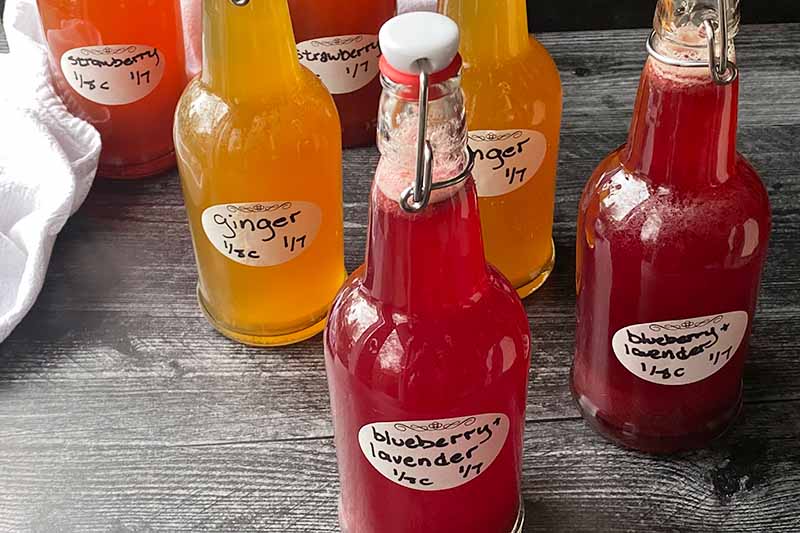
Allow the bottles to ferment undisturbed for 1 to 3 days, but no more than that! Keep note of the length of time on the jar, or in your calendar.
If you prefer less carbonation, one day is all you need. If you prefer more carbonation, allow it to ferment for up to 3 days total.
Again, to prevent a potential explosion, don’t try to bottle-ferment for longer than 3 days. Or you may be cleaning up a big mess…
Step 10 – Chill and Serve
After the set time is complete, immediately transfer all of the bottles to the refrigerator. The cold temperature will stop the fermentation process.
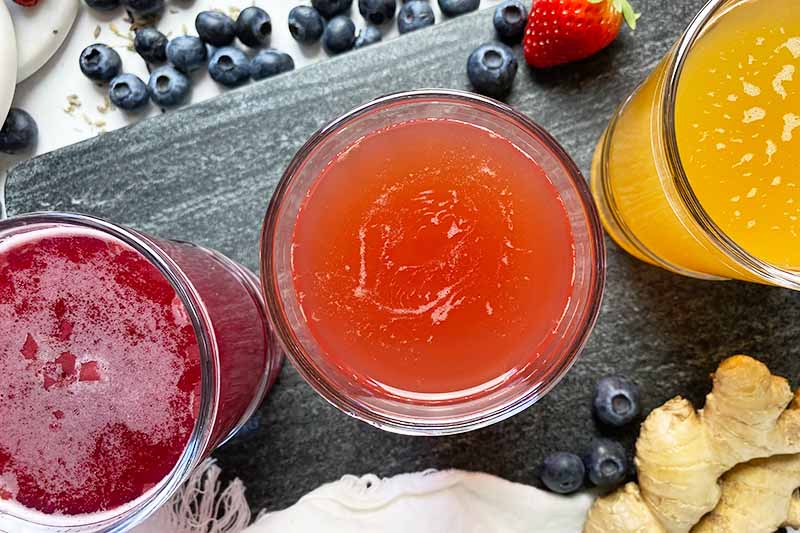
Chill for at least 24 hours – kombucha is best served cold and crisp, and 24 hours of chilling is required to slow fermentation.
As an added precaution, open each bottle over your kitchen sink when you’re ready to enjoy your homemade brew – just in case the pressure that is released is strong enough to discharge some liquid.
Enjoy every refreshing sip – you’ve earned it!
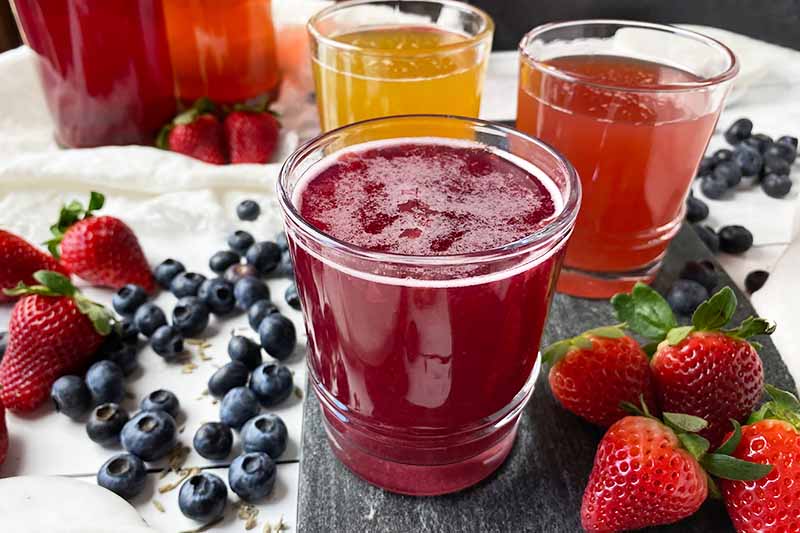
Store sealed bottles in the refrigerator for up to 3 months. Open bottles will immediately start to lose their effervescence, but they are still safe to drink if stored in the fridge for up to 3 days.
The New Cookie Swap?
I’m being serious!
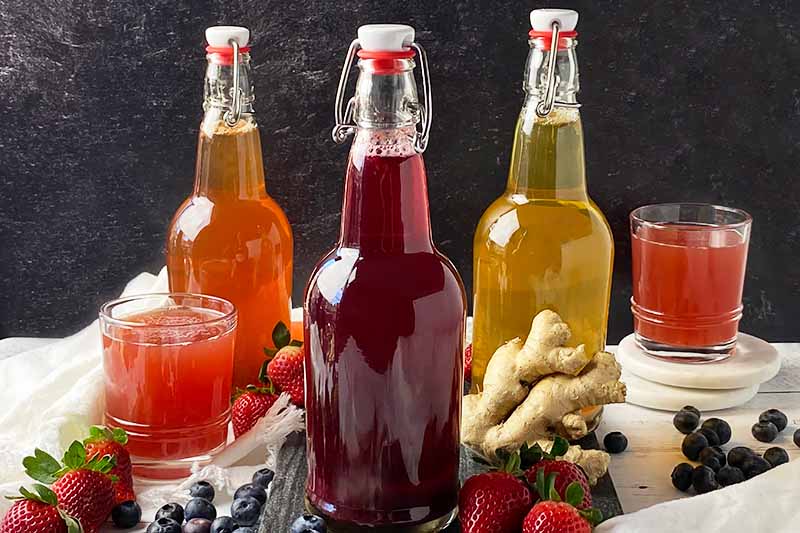
Part of the fun of brewing kombucha is sharing the results with others, taking notes on their feedback, collecting new flavor combination ideas, and continuing to brew new batches as you hone your craft.
After brewing your first six bottles, it’s all downhill from there – you’ll have a perpetual SCOBY and starter tea source available that you can use to make batch after batch.
And the excitement that you have for the process will soon rub off on others – share a healthy SCOBY or two with an interested friend or family member, impart your own words of wisdom, and start growing your group of kombucha brewers and lovers!
So, what will be your new get-together plan? Will a kombucha swap replace your next cookie exchange?
Have you tried making kombucha before? What pieces of advice are you willing to share? Leave a comment below!
Looking to kickstart your homemade beverage program? For more drink recipes featuring family-friendly bubbly beverages, try these next:
Photos by Nikki Cervone, © Ask the Experts, LLC. ALL RIGHTS RESERVED. See our TOS for more details. Originally published by Shanna Mallon on August 9, 2010. Last updated on February 24, 2023.
Nutritional information derived from a database of known generic and branded foods and ingredients and was not compiled by a registered dietitian or submitted for lab testing. It should be viewed as an approximation.
About Nikki Cervone
Nikki Cervone is an ACS Certified Cheese Professional and cheesemonger living in Pittsburgh. Nikki holds an AAS in baking/pastry from Westmoreland County Community College, a BA in Communications from Duquesne University, and an MLA in Gastronomy from Boston University. When she's not nibbling on her favorite cheeses or testing a batch of cupcakes, Nikki enjoys a healthy dose of yoga, wine, hiking, singing in the shower, and chocolate. Lots of chocolate.

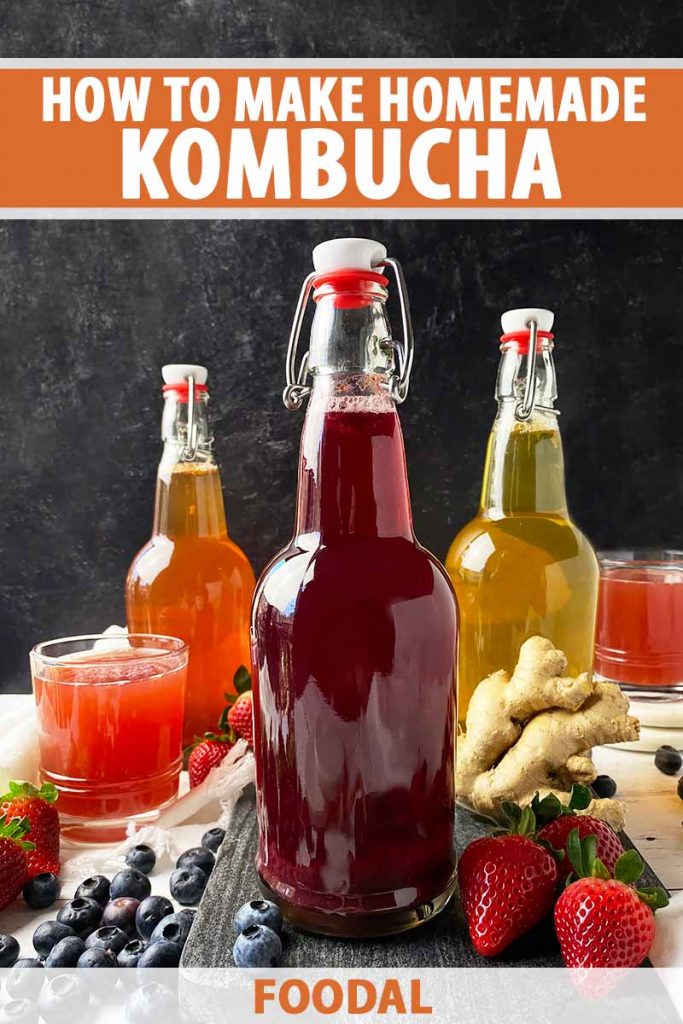




*raises hand*
Could you explain a little more about the mother? I couldn’t exactly tell by looking at the pictures. It sounds like some kind of fungi but it LOOKS like a piece of thick paper. Is that a mother in the third picture down? Is it like a filter with yeasty stuff in it or something?
wow – very interesting! I don’t know that I’ll be making my own, but I definitely feel more informed. So in case I’m out and about or attending a Bible study and someone is talking about said kombucha at least I’ll know what they’re talking about. 🙂
What Kim said! I was expecting the mother to look strange and fungi-like… is it the thin filter-looking piece? And if so, how does one share it?
I’ll admit, I find kombucha completely fascinating. I associate the taste with umeboshi plums. Fermented and kind of acidic and full of strange and wonderful probiotics – and unexpected.
I’m pretty sure it’s still on the shelves in Toronto – I guess we haven’t pulled it (yet?!) in Canada?
Is the mother bacterial or fungal (or a mix of the two)? Will different mothers give different flavors of kombucha, like the way different sour dough starters will give different flavors of bread? This sounds like a really interesting drink!
I too am a kombucha convert, and here in Cincinnati there’s a company called
Fab ferments that makes a huge variety of delicious flavors. I haven’t scored a starter yet (also called a SCOBY) but I’m anxious to make my own. Just gotta get over my fear of living bacterias and yeast!
Shanna! props to you for making this. . . how bummed were we when we learned that this addicting drink was being pulled off the shelf?! i really think my body went into complete shock! thank you for posting this and making it yourself. i think i may need to try this.
interesting! it definitely seems to have some health benefits, but dang it is putting a big hole in your pocket all the while! enter – homemade product. awesome. i might have to give this a try….
Yep, I’m sticking around 🙂 And while I probably will never make kombucha, sprouted wheat bread is one of the best things ever. So hey, that counts for something, right?
Thanks for the questions and comments, guys! I’ve started updating the Q/A above with what you wanted to know. Feel free to add more questions as you have them!
I drank local kombucha in San Francisco a few weeks ago. It had a delicate rose flavor and was lovely; even better than the bottled stuff — though just as expensive. Thoughts on why the bottled is so much? The labor intensive process? The fragility?
When people change, it can be a sad parting-of-ways event…or it can be a chance to learn something new from somebody you may have thought you knew inside and out. I love when that happens.
I made your soaked-oat granola this weekend with a just bit of trepidation, and it was yummier and crunchier than anything I’d ever tried. Count me as a fan of these 2010 changes of yours!
hm.. interesting, i used to drink something like this, which was more close to yogurt… i want to try this!!
interesting.. this stuff must be fantastic if you’re willing to make your own!
Anne – I wish I knew! Other than plain old supply and demand, I’ve no idea.
Maddie – You need to come to Chicago, and we will have lunch. I think we’d be great friends.
Hana, That sounds interesting, too!
Evan, Indeed!
My husband and I were talking about kombucha the other night. I guess now that you have spoken on it, I’ll have to try it, huh? 🙂
TJ, I love that kombucha finds its way into random conversations. Yes, try it, as soon as you see some! I’m partial to G.T.’s and locally brewed versions, and it’s good to look for ones with low sugar content. I’ll warn you now: it’s easy to get hooked! : )
My dad makes kombucha.
Something I find quite funny in my parents home is the “his & her” fridge. My dad has a small, bar sized fridge and inside are all his healthy goodies. He is always passing on helpful info. like, “eat kelp, it’s good for you” So, inside his wee fridge sits his “mother” kombucha.
I think it looks like a wet crepe.
I took my sister to our Whole foods yesterday and we now carry the brand you mentioned in a previous blog. I will have to try it.
Dad’s was just the straight up drink.
Celeste, Well I am jealous on two fronts, first that you in Canada can still buy GT’s kombucha!? and second that you have a dad who makes his own! Tell him I think that’s super cool.
I will. I am grateful for the way he will research “healthy” options and then mail them to me.
eg: “drink cranberry juice, it’s good for women”
He makes me smile.
Oh yeah,
if you ever decide to travel this far North, I would gladly show you around.
I confess I have let some of my “foodie” writing go but I could still show you around Vancouver and the popular, great eating places.
Celeste, It makes me smile, too. And you have yourself a deal. If I am ever in Vancouver, I’d love to see your favorite places!
Do you drink it with food or an empty stomach? I enjoy the fizzy drink after I eat, but want to drink it when it’s most beneficial, especially for digestion. Thanks! 🙂
Hi June, I haven’t been making kombucha lately, but when I was, and with the kind I buy at Whole Foods, I drink it any and every time I want to. : ) It’s good before meals, with meals, after meals. For the best digestion aid, you’d probably want to go with before, just like if you were taking probiotics, but it’s good for you and offers benefits anytime.